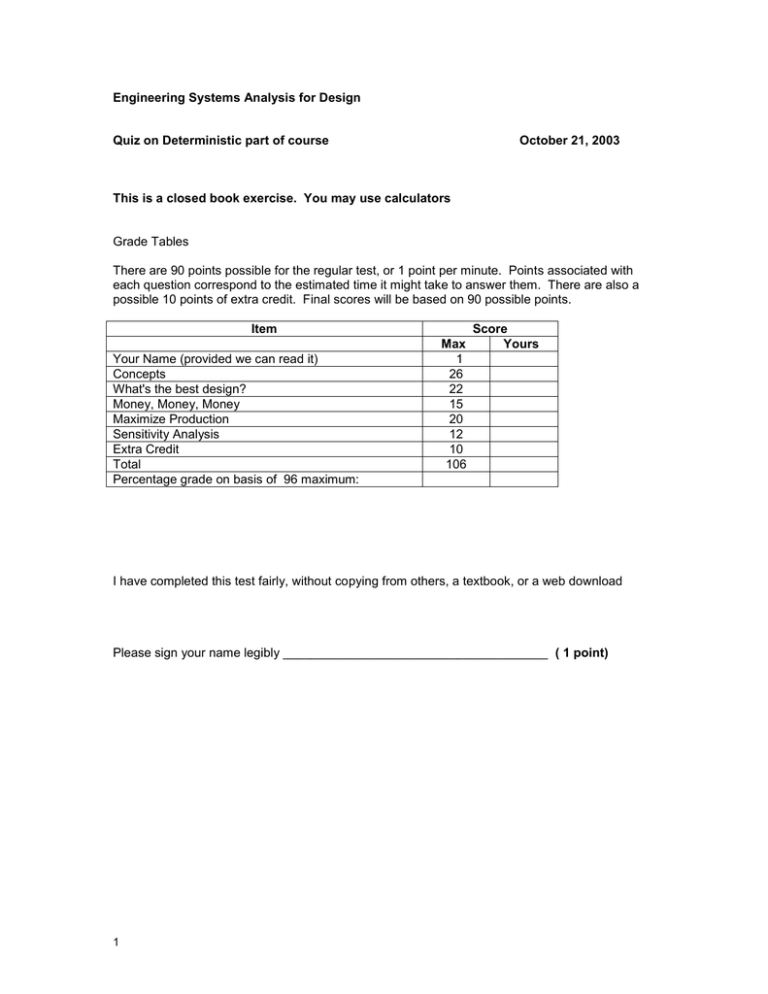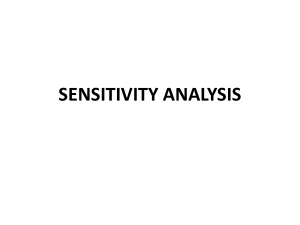Engineering Systems Analysis for Design Quiz on Deterministic part of course
advertisement

Engineering Systems Analysis for Design Quiz on Deterministic part of course October 21, 2003 This is a closed book exercise. You may use calculators Grade Tables There are 90 points possible for the regular test, or 1 point per minute. Points associated with each question correspond to the estimated time it might take to answer them. There are also a possible 10 points of extra credit. Final scores will be based on 90 possible points. Item Your Name (provided we can read it) Concepts What's the best design? Money, Money, Money Maximize Production Sensitivity Analysis Extra Credit Total Percentage grade on basis of 96 maximum: Max 1 26 22 15 20 12 10 106 Score Yours I have completed this test fairly, without copying from others, a textbook, or a web download Please sign your name legibly ______________________________________ ( 1 point) 1 Concepts (26 points -- 2 points per part) Write a short definition or description explaining each of the following: Production Function - Technical efficiency (1 point) Inputs -> outputs (1 point) Technical Efficiency - Maximum product (1 point) From given set of resources (1 point) Economic Efficiency - least cost solution (1 point) for any given level of production (1 point) Isoquant - locus of equal output (1 point) on production function – technically efficient (1 point) Returns to Scale - outputs increase more than inputs (1 point) as proportion of inputs stay constant (1 point) Economies of Scale - cheaper per unit (1 point) as scale of production increases (1 point) Shadow Prices - 2 rate of change of objective function (partial derivative) (1 point) per unit change of constraint (1 point) Opportunity Costs - worsening or degradation of optimum (1 point) per unit use of variable not in optimal set (1 point) Slack Variables - define slack (1 point) between constraint and value in optimal design (1 point) Expansion Path - locus of economically optimal design (1 point) for every level of output (1 point) Cost Function - define least cost (1 point) for each level of production (1 point) Activities - a linear combination of decision variables (1 point) defining use of these variables to achieve non-linear production function (1 point) Data Tables - 3 an Excel tool (1 point) to define sensitivity of result to change in specific parameters (1 point) What's the best design? (22 points) You are given a production function: 6 R(exp 0.4) S (exp 0.8) And the cost of the resources as: 2 R (exp 0.5) + S (exp 1.5). [Note: a (exp b) means "a" raised to the power of "b" ] a) What can you say by immediately, by inspection, about the returns to scale? The economies of scale? (4 points) RTS is increasing, because a i 0.4 0.8 1 (2 points) EOS cannot be told by inspection (2 points) b) What is the optimal relationship between the resources R and S? For simplicity, provide your answer in the form of R = K f(S) where K gathers the constant terms. (10 points) (6 R 0.4 S 0.8 ) MPR 2.4 R 0.6 S 0.8 (1 point) R (6 R 0.4 S 0.8 ) MPS 4.8R 0.4 S 0.2 (1 point) S 0.5 (1 point) MC R R 0.5 MC S 1.5S (1 point) Applying optimality condition in marginal analysis MPS MPR 9 (2 points) MC R MC S 2.4 R 0.6 S 0.8 4.8R 0.4 S 0.2 R 0.5 1.5S 0.5 1.5 0.5 3 The optimal relationship is 1.5S 2 R or R KS (2 points) (If the approach is correct, 2 points whatever the calculation is.) c) What is the associated cost function? (8 points) According the optimal relationship solved in part b) 9S 3 0.4 0.8 ) S 31.8 2 0.6 S 2 4.77 S 2 (1 point) 16 2.5S 1.5 (1 point) Z 6 R 0.4 S 0.8 6 ( C 2 R 0.5 S 1.5 0.55 1.35 3 Z ) Eliminating S to get: C 5 2 or C f ( Z Show economies of scale (1 point) (If the approach is correct, 2 points whatever the calculation is.) 4 0.75 0.75 (1 point) Money, Money, Money (15 points) What is Net present value? (3 Points) NPV = Present Value Benefits – Present Value Costs (1 point) Present value is the discounted value of future cash flows (1 point) At appropriate discount rate (1 point) What are the major advantages and disadvantages of the Benefit/Cost ratio as a criterion of evaluation? (4) Advantages: - It compares projects on a common scale. (1point) - If Benefits/Costs > 1, it is a good project. (1 point) Disadvantages: - It is biased against projects with recurring costs. (1 point) - Relative rank of projects depends on discount rate used. (1 point) Why might the rank order of projects change when you calculate their benefit-cost ratios using different discount rates? (4) Lower discount rate favors projects with long-term benefits, (2 points) because with a higher discount rate, the present value of a future benefit will be lower. (2 points) What are the reasons for and against using the pay-back period as an evaluation criterion? (4) 5 Pros: - simple (1 point) - does not require long-term forecast (1 point) Cons: - no discounting (1 point) - disregards future (1 point) Maximize Production (20 points) An electric power system needs to maximize power production from 3 plants (North, West and South) subject to constraints on the tons of NOx and CO2 (8 and 12 respectively) Each plant produces NOx and CO2 in fixed proportions per unit of power produced: Plant Pollution Production / Unit NOx CO2 3 2 2 3.5 1 4 North West South a) Draw the isoquant for 4 units of production of power (6 points) For producing 4 units of power: Power Production/4 units NOx CO2 12 8 8 14 4 16 Plant North West South So the isoquant is as the following figure: Isoquant for 4 units of power South West 20 (4,16) CO2 15 (8,14) North (8,12) 10 (12,8) 5 Isoquant 0 0 5 Constraints 10 NOx Vectors North, West, South (1 point each) Horizontal and Vertical parts (1 point) Diagonal part (2 points) b) Graphically define the optimum production plan (4) See figure above. Constraints (1 point each) Solution (8,12) (2 points) 6 15 20 c) Define the optimum production plan in terms of the amounts to be produced by each plant (5 points) Let x be the units of power produced at North plant y be the units of power produced at South plant 3 1 8 x y (2 points) 2 4 12 Solve the equations and get x=2, y=2, so the optimal production plan is 2 units power for both north and south plant (3 points) d) Set up the Linear Program. Include all necessary elements. You may use vector notation if convenient. (5 points) Let N denote the units of power produced at the north plant W denote the units of power produced at the west plant S denote the units of power produced at the south plant 7 Maximize: N + W + S (2 points) Subject to: 3N + 2W + S ≤ 8 (1 point) 2N + 3.5W + 4S ≤ 12 (1 point) N, W, S ≥ 0 (1 point) Sensitivity Analysis (12 points) Suppose you got the following results from an LP in which you were trying to minimize: Y = ci Xi subject to I aij Xi greater or equal to bj Constraint B2 B3 Shadow Price 0 30 Coefficient Opportunity Cost 0 40 C3 C4 for all j Range < 800 300<……< 600 What is the meaning of the shadow price on constraint B3? (3 points) Relaxing constraint B3 per unit, improve optimum by 30 (2 points) Relaxing means decreasing B3 (1 point) How do you interpret the opportunity cost associated with C4? (3 points) Each use of 1 unit C3 makes the optimal worse (2 points) By 40 (1 point) What can you say about the shadow price of B3 when B3 > 600? (3 points) Different from 30 (2 points) Since tightening the constraint, the shadow price is bigger (1 point) What can you say about the current value of B3? (3 points) Between 300 and 600 (3 points) 8 For 10 points extra credit: Think of yourself as the system designer for a major technological system. Your task is to figure out how to expand it over the next generation. Specifically, you must guide decisions about what should be done now by way of capacity addition. Suppose that your system has economies of scale, and that, for the prevailing discount rate and long term pattern of growth you can estimate that the optimal addition would cover the next 7 years of demand. You recognize that the future is unpredictable – what does this imply as regards the way you should design the next capacity addition to the system (4 points), More flexibility (2 points) Smaller units of addition (2 points) Define, as explicitly as you can, the advantages and disadvantages of the policy you propose. (6 points) Can react to changes (2 points) Avoids unused capacities (2 points) Gives time to learn more about forecast, market conditions, and new technologies, etc (2 points) 9

